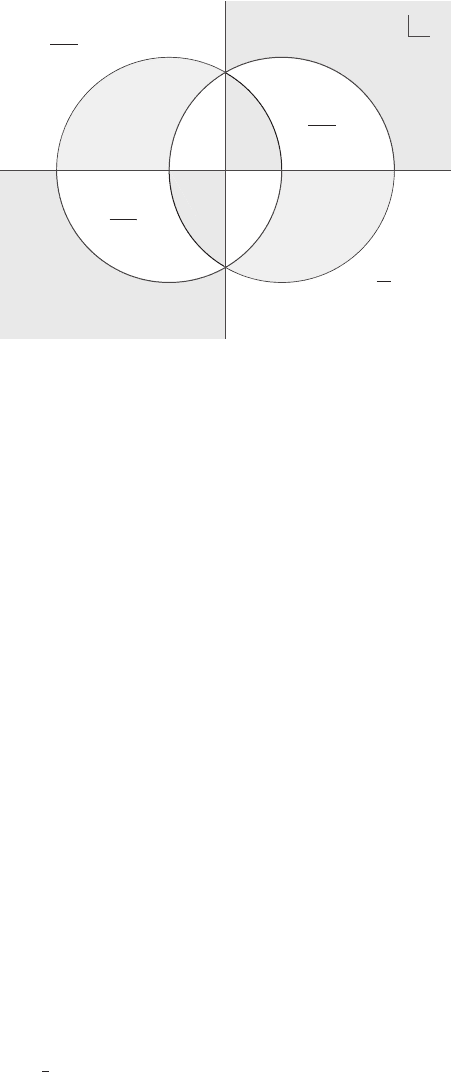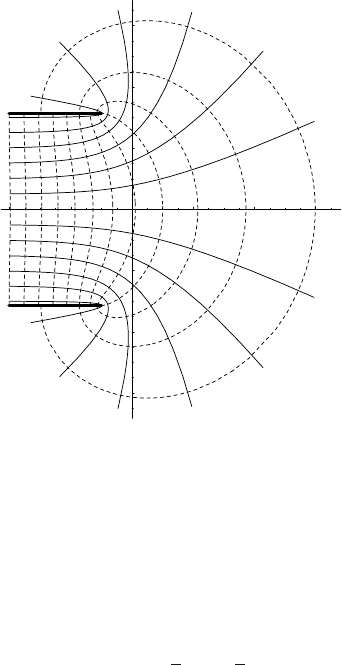Stone M., Goldbart P. Mathematics for Physics: A Guided Tour for Graduate Students
Подождите немного. Документ загружается.

16.3 Working in the total space 605
In addition to producing a convenient solution of the Wess–Zumino condition, the
descent equations provide a compact derivation of the gauge transformation properties
of useful differential forms. We will not seek to explain further the physical meaning of
these forms, leaving this to a quantum field theory course.
The similarity between A and A led various authors to attempt to identify them, and
in particular to identify v(x) with the g
−1
δg Maurer–Cartan form appearing in A. How-
ever the physical meaning of expressions such as d(g
−1
δg) precludes such a simple
interpretation. In evaluating dv ∼ d(g
−1
δg) on a vector field ξ
a
(x)L
a
representing an
infinitesimal gauge transformation, we first insert the field into v ∼ g
−1
δg to obtain
the x-dependent Lie algebra element iξ
a
(x)
=
λ
a
, and only then take the exterior deriva-
tive to obtain i
=
λ
a
∂
µ
ξ
a
dx
µ
. The result therefore involves derivatives of the components
ξ
a
(x). The evaluation of an ordinary differential form on a vector field never produces
derivatives of the vector components.
To understand what the Stora–Zumino forms are, imagine that we equip a two-
dimensional fibre bundle E = M ×F with base-space coordinate x and fibre coordinate
y .Ap = 1, q = 1 form on E will then be F = f (x, y) dx δy for some function f (x, y).
There is only one object δy , and there is no meaning to integrating F over x to leave a
1-form in δy on E. The space of forms introduced by Stora and Zumino, on the other
hand, would contain elements such as
J =
M
j(x, y) dx δy
x
(16.144)
where there is a distinct δy
x
for each x ∈ M . If we take, for example, j(x, y) = δ
(x −a),
we evaluate J on the vector field Y (x, y)∂
y
as
J [Y (x, y)∂
y
]=
δ
(x − a)Y (x, y) dx =−Y
(a, y). (16.145)
The conclusion is that the 1-form field v (x) ∼ g
−1
δg must be considered as the
left-invariant Maurer–Cartan form on the infinite dimensional Lie group G, rather than a
Maurer–Cartan form on the finite dimensional Lie group G. The
M
ω
q
2n
(v, A
g
) are there-
fore elements of the cohomology group H
q
(A
G
) of the G orbit of A, a rather complicated
object. For a thorough discussion see: J. A. de Azcárraga, J. M. Izquierdo, Lie groups,
Lie Algebras, Cohomology and some Applications in Physics (Cambridge University
Press).

17
Complex analysis
Although this chapter is called complex analysis, we will try to develop the subject as
complex calculus – meaning that we shall follow the calculus course tradition of telling
you how to do things, and explaining why theorems are true, with arguments that would
not pass for rigorous proofs in a course on real analysis. We try, however, to tell no lies.
This chapter will focus on the basic ideas that need to be understood before we
apply complex methods to evaluating integrals, analysing data and solving differential
equations.
17.1 Cauchy–Riemann equations
We focus on functions, f (z), of a single complex variable, z, where z = x + iy.We
can think of these as being complex valued functions of two real variables, x and y. For
example
f (z ) = sin z ≡ sin(x + iy) = sin x cos iy +cos x sin iy
= sin x cosh y + i cos x sinh y. (17.1)
Here, we have used
sin x =
1
2i
e
ix
− e
−ix
, sinh x =
1
2
e
x
− e
−x
,
cos x =
1
2
e
ix
+ e
−ix
, cosh x =
1
2
e
x
+ e
−x
,
to make the connection between the circular and hyperbolic functions. We shall often
write f (z) = u +iv , where u and v are real functions of x and y. In the present example,
u = sin x cosh y and v = cos x sinh y.
If all four partial derivatives
∂u
∂x
,
∂v
∂y
,
∂v
∂x
,
∂u
∂y
, (17.2)
exist and are continuous, then f = u +iv is differentiable as a complex-valued function
of two real variables. This means that we can approximate the variation in f as
δf =
∂f
∂x
δx +
∂f
∂y
δy +···, (17.3)
606

17.1 Cauchy–Riemann equations 607
where the dots represent a remainder that goes to zero faster than linearly as δx, δy go
to zero. We now regroup the terms, setting δz = δx + iδy, δ
z = δx − iδy, so that
δf =
∂f
∂z
δz +
∂f
∂z
δ
z +···, (17.4)
where we have defined
∂f
∂z
=
1
2
∂f
∂x
− i
∂f
∂y
,
∂f
∂z
=
1
2
∂f
∂x
+ i
∂f
∂y
. (17.5)
Now our function f (z) does not depend on
z, and so it must satisfy
∂f
∂z
= 0. (17.6)
Thus, with f = u + iv,
1
2
∂
∂x
+ i
∂
∂y
(u + iv) = 0 (17.7)
i.e.
∂u
∂x
−
∂v
∂y
+ i
∂v
∂x
+
∂u
∂y
= 0. (17.8)
Since the vanishing of a complex number requires the real and imaginary parts to be
separately zero, this implies that
∂u
∂x
=+
∂v
∂y
,
∂v
∂x
=−
∂u
∂y
. (17.9)
These two relations between u and v are known as the Cauchy–Riemann equations,
although they were probably discovered by Gauss. If our continuous partial derivatives
satisfy the Cauchy–Riemann equations at z
0
= x
0
+ iy
0
then we say that the function
is complex differentiable (or just differentiable) at that point. By taking δz = z − z
0
,
we have
δf
def
= f (z) − f (z
0
) =
∂f
∂z
(z − z
0
) +···, (17.10)

608 17 Complex analysis
where the remainder, represented by the dots, tends to zero faster than |z −z
0
|as z → z
0
.
The validity of this linear approximation to the variation in f (z) is equivalent to the
statement that the ratio
f (z ) − f (z
0
)
z − z
0
(17.11)
tends to a definite limit as z → z
0
from any direction. It is the direction-independence
of this limit that provides a proper meaning to the phrase “does not depend on
z”. Since
we are not allowing dependence on ¯z, it is natural to drop the partial derivative signs and
write the limit as an ordinary derivative
lim
z→z
0
f (z ) − f (z
0
)
z − z
0
=
df
dz
. (17.12)
We will also use Newton’s fluxion notation
df
dz
= f
(z). (17.13)
The complex derivative obeys exactly the same calculus rules as ordinary real derivatives:
d
dz
z
n
= nz
n−1
,
d
dz
sin z = cos z,
d
dz
(fg) =
df
dz
g + f
dg
dz
, etc. (17.14)
If the function is differentiable at all points in an arcwise-connected
1
open set, or
domain, D, the function is said to be analytic there. The words regular or holomorphic
are also used.
17.1.1 Conjugate pairs
The functions u and v comprising the real and imaginary parts of an analytic function are
said to form a pair of harmonic conjugate functions. Such pairs have many properties
that are useful for solving physical problems.
From the Cauchy–Riemann equations we deduce that
∂
2
∂x
2
+
∂
2
∂y
2
u = 0,
∂
2
∂x
2
+
∂
2
∂y
2
v = 0 (17.15)
1
Arcwise-connected means that any two points in D can be joined by a continuous path that lies wholly within
D.

17.1 Cauchy–Riemann equations 609
and so both the real and imaginary parts of f (z) are automatically harmonic functions
of x, y.
Further, from the Cauchy–Riemann conditions, we deduce that
∂u
∂x
∂v
∂x
+
∂u
∂y
∂v
∂y
= 0. (17.16)
This means that ∇u ·∇v = 0. We conclude that, provided that neither of these gradients
vanishes, the pair of curves u = const. and v = const. intersect at right angles. If we
regard u as the potential φ solving some electrostatics problem ∇
2
φ = 0, then the curves
v = const. are the associated field lines.
Another application is to fluid mechanics. If v is the velocity field of an irrotational
(curl v = 0) flow, then we can (perhaps only locally) write the flow field as a gradient
v
x
= ∂
x
φ,
v
y
= ∂
y
φ, (17.17)
where φ is a velocity potential. If the flow is incompressible (div v = 0), then we can
(locally) write it as a curl
v
x
= ∂
y
χ,
v
y
=−∂
x
χ, (17.18)
where χ is a stream function. The curves χ = const. are the flow streamlines. If the
flow is both irrotational and incompressible, then we may use either φ or χ to represent
the flow, and, since the two representations must agree, we have
∂
x
φ =+∂
y
χ,
∂
y
φ =−∂
x
χ. (17.19)
Thus φ and χ are harmonic conjugates, and so the complex combination = φ +iχ is
an analytic function called the complex stream function.
A conjugate v exists (at least locally) for any harmonic function u. To see why, assume
first that we have a (u, v) pair obeying the Cauchy–Riemann equations. Then we can
write
dv =
∂v
∂x
dx +
∂v
∂y
dy
=−
∂u
∂y
dx +
∂u
∂x
dy . (17.20)
This observation suggests that if we are given a harmonic function u in some simply
connected domain D,wecandefine a v by setting
v(z) =
z
z
0
−
∂u
∂y
dx +
∂u
∂x
dy
+ v (z
0
), (17.21)

610 17 Complex analysis
for some real constant v(z
0
) and point z
0
. The integral does not depend on choice of path
from z
0
to z, and so v(z) is well defined. The path independence comes about because
the curl
∂
∂y
−
∂u
∂y
−
∂
∂x
∂u
∂x
=−∇
2
u (17.22)
vanishes, and because in a simply connected domain all paths connecting the same
endpoints are homologous.
We now verify that this candidate v(z) satisfies the Cauchy–Riemann relations. The
path independence allows us to make our final approach to z = x + iy along a straight
line segment lying on either the x-ory-axis. If we approach along the x-axis, we have
v(z) =
x
−
∂u
∂y
dx
+ rest of integral, (17.23)
and may use
d
dx
x
f (x
, y) dx
= f (x, y) (17.24)
to see that
∂v
∂x
=−
∂u
∂y
(17.25)
at (x, y). If, instead, we approach along the y-axis, we may similarly compute
∂v
∂y
=
∂u
∂x
. (17.26)
Thus v(z) does indeed obey the Cauchy–Riemann equations.
Because of the utility of the harmonic conjugate it is worth giving a practical recipe
for finding it, and so obtaining f (z) when given only its real part u(x, y). The method we
give below is one we learned from John d’Angelo. It is more efficient than those given
in most textbooks. We first observe that if f is a function of z only, then
f (z ) depends
only on
z. We can therefore define a function f of z by setting f (z) = f (z). Now
1
2
f (z ) +
f (z )
= u(x, y). (17.27)
Set
x =
1
2
(z +
z), y =
1
2i
(z −
z), (17.28)
so
u
1
2
(z +
z),
1
2i
(z −
z)
=
1
2
f (z ) +
f (z )
. (17.29)

17.1 Cauchy–Riemann equations 611
Now set
z = 0, while keeping z fixed! Thus
f (z ) +
f (0) = 2u
z
2
,
z
2i
. (17.30)
The function f is not completely determined of course, because we can always add a
constant to v, and so we have the result
f (z ) = 2u
z
2
,
z
2i
+ iC, C ∈ R. (17.31)
For example, let u = x
2
− y
2
. We find
f (z ) +
f (0) = 2
z
2
2
− 2
z
2i
2
= z
2
, (17.32)
or
f (z ) = z
2
+ iC, C ∈ R. (17.33)
The business of setting
z = 0, while keeping z fixed, may feel like a dirty trick, but it
can be justified by the (as yet to be proved) fact that f has a convergent expansion as a
power series in z = x +iy. In this expansion it is meaningful to let x and y themselves be
complex, and so allow z and
z to become two independent complex variables. Anyway,
you can always check ex post facto that your answer is correct.
17.1.2 Conformal mapping
An analytic function w = f (z) maps subsets of its domain of definition in the “z” plane
on to subsets in the “w” plane. These maps are often useful for solving problems in two-
dimensional electrostatics or fluid flow. Their simplest property is geometrical: such
maps are conformal (Figure 17.1).
Suppose that the derivative of f (z) at a point z
0
is non-zero. Then, for z near z
0
we have
f (z ) − f (z
0
) ≈ A(z −z
0
), (17.34)
where
A =
df
dz
!
!
!
!
z
0
. (17.35)
If you think about the geometric interpretation of complex multiplication (multiply the
magnitudes, add the arguments) you will see that the “f ” image of a small neighbourhood
of z
0
is stretched by a factor |A|, and rotated through an angle arg A – but relative angles
are not altered. The map z (→ f (z) = w is therefore isogonal. Our map also preserves

612 17 Complex analysis
Z
Z
10
1–Z
Z
1
Z
1–Z
1
1–Z
Z–1
Z
Figure 17.1 An illustration of conformal mapping. The unshaded “triangle” marked z is mapped
into the other five unshaded regions by the functions labelling them. Observe that although the
regions are distorted, the angles of the “triangle” are preserved by the maps (with the exception
of those corners that get mapped to infinity).
orientation (the sense of rotation of the relative angle) and these two properties, isogo-
nality and orientation-preservation, are what make the map conformal.
2
The conformal
property fails at points where the derivative vanishes or becomes infinite.
If we can find a conformal map z (≡ x + iy) (→ w (≡ u + iv) of some domain D
to another D
then a function f (z) that solves a potential theory problem (a Dirichlet
boundary value problem, for example) in D will lead to f (z(w )) solving an analogous
problem in D
.
Consider, for example, the map z (→ w = z + e
z
. This map takes the strip
−∞ < x < ∞, −π ≤ y ≤ π to the entire complex plane with cuts from −∞ + iπ
to −1 +iπ and from −∞ − iπ to −1 − iπ. The cuts occur because the images of the
lines y =±π get folded back on themselves at w =−1 ± iπ, where the derivative of
w(z) vanishes (see Figure 17.2).
In this case, the imaginary part of the function f (z) = x + iy trivially solves the
Dirichlet problem ∇
2
x,y
y = 0 in the infinite strip, with y = π on the upper boundary and
y =−π on the lower boundary. The function y(u, v), now quite non-trivially, solves
∇
2
u,
v
y = 0 in the entire w plane, with y = π on the half-line running from −∞ + iπ
to −1 + iπ , and y =−π on the half-line running from −∞− iπ to −1 − iπ . We may
regard the images of the lines y = const. (solid curves) as being the streamlines of an
irrotational and incompressible flow out of the end of a tube into an infinite region, or
as the equipotentials near the edge of a pair of capacitor plates. In the latter case, the
images of the lines x = const. (dotted curves) are the corresponding field-lines
2
If f were a function of z only, then the map would still be isogonal, but would reverse the orientation. We
call such maps antiholomorphic or anticonformal.

17.1 Cauchy–Riemann equations 613
–4 –2 2 4 6
–6
–4
–2
2
4
6
Figure 17.2 Image of part of the strip −π ≤ y ≤ π, −∞ < x < ∞ under the map z (→ w =
z + e
z
.
Example: The Joukowski map. This map is famous in the history of aeronautics because
it can be used to map the exterior of a circle to the exterior of an aerofoil-shaped region.
We can use the Milne–Thomson circle theorem (see Section 17.3.2) to find the streamlines
for the flow past a circle in the z plane, and then use Joukowski’s transformation,
w = f (z) =
1
2
z +
1
z
, (17.36)
to map this simple flow to the flow past the aerofoil. To produce an aerofoil shape, the
circle must go through the point z = 1, where the derivative of f vanishes, and the image
of this point becomes the sharp trailing edge of the aerofoil.
The Riemann mapping theorem
There are tables of conformal maps for D, D
pairs, but an underlying principle is
provided by the Riemann mapping theorem (Figure 17.3):
Theorem: The interior of any simply connected domain D in C whose boundary consists
of more that one point can be mapped conformally one-to-one and onto the interior of
the unit circle. It is possible to choose an arbitrary interior point w
0
of D and map it to
the origin, and to take an arbitrary direction through w
0
and make it the direction of the
real axis. With these two choices the mapping is unique.
This theorem was first stated in Riemann’s PhD thesis in 1851. He regarded it as
“obvious” for the reason that we will give as a physical “proof”. Riemann’s argument

614 17 Complex analysis
f
D
w
0
w
O
z
Figure 17.3 The Riemann mapping theorem.
is not rigorous, however, and it was not until 1912 that a real proof was obtained by
Constantin Carathéodory. A proof that is both shorter and more in spirit of Riemann’s
ideas was given by Leopold Fejér and Frigyes Riesz in 1922.
For the physical “proof”, observe that in the function
−
1
2π
ln z =−
1
2π
{
ln |z|+iθ
}
, (17.37)
the real part φ =−
1
2π
ln |z| is the potential of a unit charge at the origin, and with the
additive constant chosen so that φ = 0 on the circle |z|=1. Now imagine that we
have solved the two-dimensional electrostatics problem of finding the potential for a
unit charge located at w
0
∈ D, also with the boundary of D being held at zero potential.
We have
∇
2
φ
1
=−δ
2
(w − w
0
), φ
1
= 0on∂D. (17.38)
Now find the φ
2
that is harmonically conjugate to φ
1
. Set
φ
1
+ iφ
2
= (w) =−
1
2π
ln(ze
iα
) (17.39)
where α is a real constant. We see that the transformation w (→ z,or
z = e
−iα
e
−2π(w)
, (17.40)
does the job of mapping the interior of D into the interior of the unit circle, and the
boundary of D to the boundary of the unit circle. Note how our freedom to choose the
constant α is what allows us to “take an arbitrary direction through w
0
and make it the
direction of the real axis”.
Example: To find the map that takes the upper half-plane into the unit circle, with the
point z = i mapping to the origin, we use the method of images to solve for the complex
